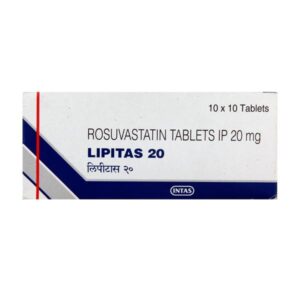AMLODIPINE + ATORVASTATIN
Amlodipine: Amlodipine is a medication primarily used to treat high blood pressure (hypertension) and chest pain (angina). It belongs to a class of drugs known as calcium channel blockers.
The primary mechanism of action of amlodipine is its ability to block the influx of calcium ions into smooth muscle cells and cardiac muscle cells. By doing so, it reduces the contraction of the muscles in the arteries, leading to vasodilation and a decrease in blood pressure. Additionally, it dilates the coronary arteries, improving blood flow to the heart and relieving chest pain.
The usual starting dose of amlodipine for treating hypertension is 5 mg once daily. However, the dosage may vary depending on individual patient factors and the severity of the condition. It may be increased up to a maximum dose of 10 mg per day. For angina, the usual dose range is 5-10 mg once daily.
Like other medications, amlodipine can cause side effects. Common side effects include dizziness, swelling of the ankles or feet (edema), fatigue, flushing, headache, abdominal pain, and nausea. Some individuals may experience a rapid or irregular heartbeat or develop a rash while taking amlodipine. In rare cases, it can cause severe allergic reactions or liver problems. It is important to notify a healthcare professional if any side effects occur or if there are any concerns while taking this medication.
It is essential to follow the prescribed dosage and continue taking amlodipine as directed by the healthcare provider. Suddenly stopping the medication can lead to a sudden increase in blood pressure or worsening of angina symptoms. Regular blood pressure monitoring and follow-up visits with a healthcare professional are necessary to ensure the medication is effective and well-tolerated.
Atorvastatin: Atorvastatin, commonly sold under the brand name Lipitor, is a medication used to lower high levels of cholesterol and triglycerides in the blood. It falls under the class of drugs called statins. Atorvastatin is primarily prescribed to lower the risk of developing cardiovascular diseases, such as heart attack and stroke, in individuals with conditions like high cholesterol or a history of heart disease.
The drug works by inhibiting the enzyme HMG-CoA reductase, which plays a key role in cholesterol synthesis in the liver. By reducing the activity of this enzyme, atorvastatin effectively lowers the levels of “bad” cholesterol (low-density lipoprotein or LDL) while increasing the levels of “good” cholesterol (high-density lipoprotein or HDL).
The prescribed dosage of atorvastatin is generally tailored to the individual’s specific needs. The typical starting dose is usually 10 to 20 milligrams (mg) per day, and it can be increased up to 80 mg per day, depending on the patient’s response and cholesterol levels. The medication can be taken with or without food and is typically taken once daily.
As with any medication, atorvastatin has potential side effects. Common side effects include muscle pain, joint pain, headache, diarrhea, and constipation. In rare cases, atorvastatin can cause more serious side effects, such as liver problems (indicated by yellowing of the eyes or skin, dark urine, or persistent nausea), muscle damage (characterized by unusual muscle pain or weakness), or an allergic reaction.
It is important to note that atorvastatin may interact with other medications, so it is crucial to inform healthcare professionals about all other drugs being taken. Additionally, pregnant or breastfeeding women are generally advised to avoid using atorvastatin due to potential risks to the fetus or infant.
Overall, atorvastatin is an effective medication for reducing cholesterol levels and lowering the risk of cardiovascular diseases when used as directed by a healthcare professional. It is important to follow prescribed dosages, report any side effects to a doctor, and maintain regular check-ups to monitor cholesterol levels and overall health.

